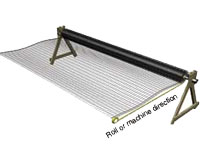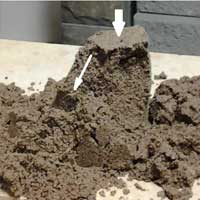Retaining Soil with Compaction and Geogrid

Geogrid Reinforcement

Retaining wall block can be used to construct walls that retain, or prevent the movement of the soil. The maximum height these walls can be built without the use of reinforcement is dependent on these primary conditions.
- Size and mass of the block
- Existing soil and retained slope conditions
- Set back of the retaining wall
Retaining walls that rely solely on their weight to retain the soil behind them are called gravity walls. When taller wall heights are required or certain site conditions exist such as surcharges or a slope above the wall, a reinforced wall is constructed.

Shear is the force applied when using a pair of scissors

Friction Angle
One method of reinforcing an Allan Block retaining wall is to use geogrid. Geogrid is a flexible mesh that is used to create a reinforced coherent mass behind the retaining wall by stabilizing the soil.
The stability of the soil depends greatly on the friction angle it contains. The friction angle is often referred to as the shear strength of the soil. Shear is the force that is applied when using a pair of scissors. In soil, the friction angle is the maximum shear force between particles of soil as they try to pass each other.
To visualize the friction angle of soil, think about a pile of soil on the ground. When you pile soil on the ground it naturally forms a conical shape. The steepness of the cone is directly related to the friction angle of the soil. If you have a rough gravelly soil you can pile it into a steeper cone than if you have a soft finely grained soil. See the Soils Chart for more information of friction angles and soil.

The Sand Castle Test

Unreinforced Soil

Reinforced Soil
The "Sand Castle" Demonstration
How is it possible for this simple cylinder of soil to support this concrete block while the other one failed? The answer is geogrid reinforcement. Geogrid adds significant strength to the soil cylinder and prevents it from failing.
Materials Used:
- 2 Tubes
- 5 Screens (Circular Shaped)
- Sand (wet)
- Compaction Tool
- Sand Scooper
The sand castle test takes two cylinders of soil and applies vertical force to see how the soil performs. The first cylinder is just compacted material. The second is also compacted material with the addition of mesh screens to simulate the use of geogrid reinforcement.
From this example you can see how the geogrid reinforces the soil mass so that it can withstand much more force. It also helps the soil that is reinforced to act as one coherent gravity mass. If you consider a simple gravity retaining wall, the forces from the soil being retained must be retained by the mass of the wall blocks. When you use geogrid with a retaining wall, the mass of the blocks and the additional mass of the reinforced soil helps to withstand the pressures behind the wall. This combined mass is what allows very tall walls to be built when using geogrid.
Note: By increasing the length of geogrid in the wall, you increase the mass of the structure and therefore can build taller walls. You cannot increase the mass of the structure by using more layers of geogrid however. Using more layers of geogrid only helps to make the mass you are working with act more coherently as a single mass.

